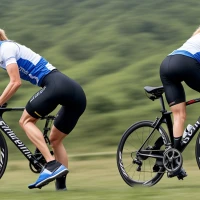Discovering the perfect bike fit is akin to finding the missing piece of a puzzle that transforms an ordinary ride into a symphony of comfort and efficiency. As cycling enthusiasts know well, a well-fitted bike is the cornerstone of a joyful, performance-enhanced cycling experience. Whether you’re gliding through city streets or conquering rugged trails, the importance of precise bike measurements cannot be overstated. Let’s embark on this comprehensive guide to ensure your cycling is simplified and tailored just for you.
Cycling isn’t merely a sport or a form of transport; it’s a passion that requires the ideal harmony between rider and machine. A bike that fits like a glove will boost your riding comfort, enhance your control over the bicycle, and significantly reduce the risk of injuries. Every bend and flex is heavily influenced by how well the size of the bike complements your body’s dimensions. The goal is to measure bike size not just accurately, but also in a way that conforms seamlessly to your riding style and body geometry.
The Fundamentals of Bike Sizing
Before diving into the nitty-gritty details of bike measurements, it’s important to understand the basic parameters that influence your bike size. Every cyclist needs to be familiar with these, as they form the bedrock of optimal bike fit.
Understanding Bike Frame Geometry
The bike frame is the skeleton of your two-wheeled steed—the foundation that determines bike sizing efficiency. It’s not just about the height of the frame, but also its length and the angle at which various tubes are set. Key dimensions include the top tube length, seat tube length, and head tube length.
Key Measurements for the Rider
To measure bike size effectively, one must account for the rider’s body measurements. Here are some crucial biometrics:
- Inseam Length: Vital for determining the standover height of the bike.
- Arm Length: Plays a role in ascertaining the reach to the handlebars.
- Torso Length: Helps determine the appropriate top tube length.
- Overall Height: Offers a preliminary clue about the size range you should consider.
Step-by-Step Guide to Measuring Your Inseam
Your inseam is a critical metric that will lead you to the most accurate frame size for your body. Follow these steps carefully to obtain precise measurements.
Acquiring the Correct Inseam Measurement
Equipment and Setup
- Find a sturdy, flat wall and a level floor to stand against.
- You’ll need a hardcover book or a similar makeshift tool.
- Have a tape measure in inches or centimeters handy.
- Wear your cycling shorts or tight-fitting attire for accurate results.
Measuring Process
- Stand straight with your back against the wall and feet about 6 inches apart.
- Place the book spine-up between your legs and simulate a bike saddle.
- Ensure the book is snug and level, then mark the point on the wall where the book’s top aligns with your inseam.
- Measure from the floor to this mark—that’s your inseam length.
Sizing Up the Right Bike Frame
Once you’ve got your inseam length, you’re well on your way to identifying the bike cycling benefits that fits best.
How Inseam Length Influences Bike Size
Comparing your inseam measurement with how cycling can save the world bike’s standover height is critical. The standover height is the distance from the top tube to the ground. Ideally, when you’re straddling the bike, there should be about one to two inches of clearance for road bikes and about two to four inches for mountain bikes.
Bike Sizing Charts and What They Mean for You
Bike sizing charts are a streamlined path to finding a good starting point for your bike search. They match your height and inseam to a theoretical bike size, commonly measured in centimeters for road bikes and inches for mountain bikes.
Customizing the Fit: Beyond the Numbers
Knowing the numbers what is hand cycling one thing, but making them work for your unique build is where the true art of bike fitting begins.
Adjusting the Saddle Height and Position
- Proper Saddle Height: Can be estimated by multiplying your inseam by 0.883. Fine-tuning will require some testing and adjustments while riding.
- Saddle Fore/Aft Position: Influences your reach to the pedals and handlebars. The knee should be over the pedal spindle when the pedal is at 3 o’clock position.
Finding the Right Reach to Handlebars
The distance from the saddle to the handlebars, or the reach, affects your comfort and efficiency on the bike. A fit that’s too long or too short can lead to back pain or handling issues. It’s sometimes measured by arm length, paired with torso measurements.
Advanced Bike Fitting Techniques
Professional bike fitting takes your cycling experience to the next level by analyzing your posture, flexibility, and riding style to fine-tune your bike’s dimensions.
Dynamic Bike Fit Considerations
- Pedal Stroke Analysis: An examination of your pedaling to optimize saddle height and position.
- Handlebar Width and Drop: Your shoulder width and flexibility play into these aspects of the fit.
- Cleat Positioning: For those using clipless pedals, correct cleat placement is essential for knee health and pedaling efficiency.
Selecting the Right Bike Type
Regardless of which biking discipline fascinates you, selecting the right type of bike is critical.
Road Bikes: Aerodynamics and Speed
For cyclists whose hearts beat faster at the thought of smooth asphalt and wind in the face, road bikes are your chariots of choice.
- Lean Geometry: Designed for speed and efficiency on the tarmac.
- Sculpted Frames: Built to be as lightweight and aerodynamic as possible.
- Variety of Sizes: Available in numerous sizes to fit all riders.
Mountain Bikes: Trail Taming Machines
Mountain bike enthusiasts seek bikes able to deal with uneven terrain with grace and power.
- Robust Frames: Constructed to withstand the rigors of off-road riding.
- Suspension Options: Ranging from hardtails to full-suspension models.
- Wheel and Tire Size: Affect the ride quality and overall bike fit.
Hybrid Bikes: Versatility at Its Best
For a blend of road efficiency and some off-road capability, a hybrid bike strikes a comfortable balance.
- Comfortable Geometry: Suitable for commuting, fitness riding, and light off-road use.
- Focus on Upright Posture: Generally designed for a more relaxed ride.
- Flexible Sizing: Accommodates various rider heights easily.
Tying It All Together: Riding in Comfort and Style
Now that we’ve explored the realms of cycle fitting, you’re equipped to spring into action and make every pedal stroke count.
Test Rides: The Truest Measure
Just as in life, the proof of the pudding is in the tasting. Test riding different bikes to feel the fit cannot be replaced by any measurement.
Maintenance and Adaptation Over Time
Even the best-fitting bike will require maintenance and occasional re-fitting as your riding style evolves.
Networking with Expert Fitters
Nothing beats the trained eye of a professional bike fitter who can fine-tune aspects of bike size that we might overlook.
Conclusion: Embrace Your Perfect Cycling Fit
To measure bike size is to invest in future moments of unadulterated joy on two wheels. Ensuring a comfortable, efficient, and tailored bike fit is the unsung hero of epic rides and personal bests. Now, go forth—empowered by knowledge and backed by precision measurements—to claim the ride that waits to amplify every cycling aspiration you hold dear. May the road rise up to meet you and the breeze be always at your back, on a bike that’s just right for you.










